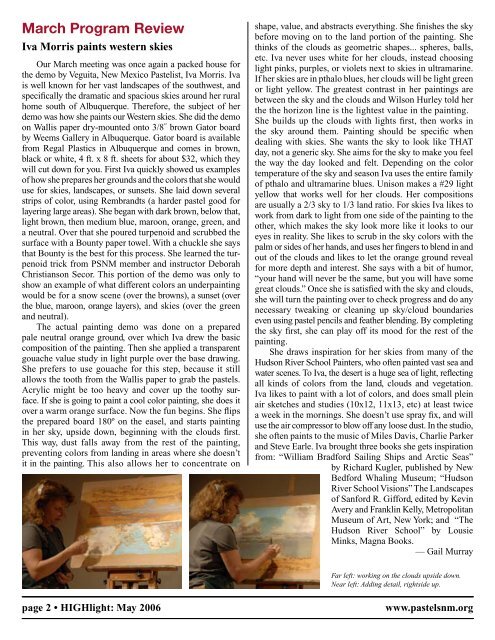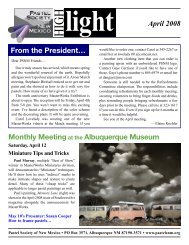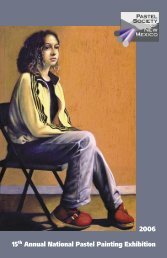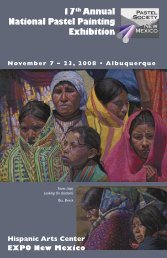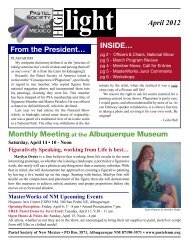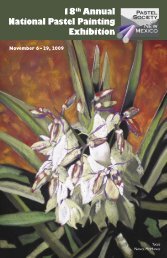May 2006 Highlight - Pastel Society of New Mexico
May 2006 Highlight - Pastel Society of New Mexico
May 2006 Highlight - Pastel Society of New Mexico
You also want an ePaper? Increase the reach of your titles
YUMPU automatically turns print PDFs into web optimized ePapers that Google loves.
March Program Review<br />
Iva Morris paints western skies<br />
Our March meeting was once again a packed house for<br />
the demo by Veguita, <strong>New</strong> <strong>Mexico</strong> <strong>Pastel</strong>ist, Iva Morris. Iva<br />
is well known for her vast landscapes <strong>of</strong> the southwest, and<br />
specifically the dramatic and spacious skies around her rural<br />
home south <strong>of</strong> Albuquerque. Therefore, the subject <strong>of</strong> her<br />
demo was how she paints our Western skies. She did the demo<br />
on Wallis paper dry-mounted onto 3/8˝ brown Gator board<br />
by Weems Gallery in Albuquerque. Gator board is available<br />
from Regal Plastics in Albuquerque and comes in brown,<br />
black or white, 4 ft. x 8 ft. sheets for about $32, which they<br />
will cut down for you. First Iva quickly showed us examples<br />
<strong>of</strong> how she prepares her grounds and the colors that she would<br />
use for skies, landscapes, or sunsets. She laid down several<br />
strips <strong>of</strong> color, using Rembrandts (a harder pastel good for<br />
layering large areas). She began with dark brown, below that,<br />
light brown, then medium blue, maroon, orange, green, and<br />
a neutral. Over that she poured turpenoid and scrubbed the<br />
surface with a Bounty paper towel. With a chuckle she says<br />
that Bounty is the best for this process. She learned the turpenoid<br />
trick from PSNM member and instructor Deborah<br />
Christianson Secor. This portion <strong>of</strong> the demo was only to<br />
show an example <strong>of</strong> what different colors an underpainting<br />
would be for a snow scene (over the browns), a sunset (over<br />
the blue, maroon, orange layers), and skies (over the green<br />
and neutral).<br />
The actual painting demo was done on a prepared<br />
pale neutral orange ground, over which Iva drew the basic<br />
composition <strong>of</strong> the painting. Then she applied a transparent<br />
gouache value study in light purple over the base drawing.<br />
She prefers to use gouache for this step, because it still<br />
allows the tooth from the Wallis paper to grab the pastels.<br />
Acrylic might be too heavy and cover up the toothy surface.<br />
If she is going to paint a cool color painting, she does it<br />
over a warm orange surface. Now the fun begins. She flips<br />
the prepared board 180º on the easel, and starts painting<br />
in her sky, upside down, beginning with the clouds first.<br />
This way, dust falls away from the rest <strong>of</strong> the painting,<br />
preventing colors from landing in areas where she doesn’t<br />
it in the painting. This also allows her to concentrate on<br />
shape, value, and abstracts everything. She finishes the sky<br />
before moving on to the land portion <strong>of</strong> the painting. She<br />
thinks <strong>of</strong> the clouds as geometric shapes... spheres, balls,<br />
etc. Iva never uses white for her clouds, instead choosing<br />
light pinks, purples, or violets next to skies in ultramarine.<br />
If her skies are in pthalo blues, her clouds will be light green<br />
or light yellow. The greatest contrast in her paintings are<br />
between the sky and the clouds and Wilson Hurley told her<br />
the the horizon line is the lightest value in the painting.<br />
She builds up the clouds with lights first, then works in<br />
the sky around them. Painting should be specific when<br />
dealing with skies. She wants the sky to look like THAT<br />
day, not a generic sky. She aims for the sky to make you feel<br />
the way the day looked and felt. Depending on the color<br />
temperature <strong>of</strong> the sky and season Iva uses the entire family<br />
<strong>of</strong> pthalo and ultramarine blues. Unison makes a #29 light<br />
yellow that works well for her clouds. Her compositions<br />
are usually a 2/3 sky to 1/3 land ratio. For skies Iva likes to<br />
work from dark to light from one side <strong>of</strong> the painting to the<br />
other, which makes the sky look more like it looks to our<br />
eyes in reality. She likes to scrub in the sky colors with the<br />
palm or sides <strong>of</strong> her hands, and uses her fingers to blend in and<br />
out <strong>of</strong> the clouds and likes to let the orange ground reveal<br />
for more depth and interest. She says with a bit <strong>of</strong> humor,<br />
“your hand will never be the same, but you will have some<br />
great clouds.” Once she is satisfied with the sky and clouds,<br />
she will turn the painting over to check progress and do any<br />
necessary tweaking or cleaning up sky/cloud boundaries<br />
even using pastel pencils and feather blending. By completing<br />
the sky first, she can play <strong>of</strong>f its mood for the rest <strong>of</strong> the<br />
painting.<br />
She draws inspiration for her skies from many <strong>of</strong> the<br />
Hudson River School Painters, who <strong>of</strong>ten painted vast sea and<br />
water scenes. To Iva, the desert is a huge sea <strong>of</strong> light, reflecting<br />
all kinds <strong>of</strong> colors from the land, clouds and vegetation.<br />
Iva likes to paint with a lot <strong>of</strong> colors, and does small plein<br />
air sketches and studies (10x12, 11x13, etc) at least twice<br />
a week in the mornings. She doesn’t use spray fix, and will<br />
use the air compressor to blow <strong>of</strong>f any loose dust. In the studio,<br />
she <strong>of</strong>ten paints to the music <strong>of</strong> Miles Davis, Charlie Parker<br />
and Steve Earle. Iva brought three books she gets inspiration<br />
from: “William Bradford Sailing Ships and Arctic Seas”<br />
by Richard Kugler, published by <strong>New</strong><br />
Bedford Whaling Museum; “Hudson<br />
River School Visions” The Landscapes<br />
<strong>of</strong> Sanford R. Gifford, edited by Kevin<br />
Avery and Franklin Kelly, Metropolitan<br />
Museum <strong>of</strong> Art, <strong>New</strong> York; and “The<br />
Hudson River School” by Lousie<br />
Minks, Magna Books.<br />
— Gail Murray<br />
Far left: working on the clouds upside down.<br />
Near left: Adding detail, rightside up.<br />
page 2 • HIGHlight: <strong>May</strong> <strong>2006</strong><br />
www.pastelsnm.org


